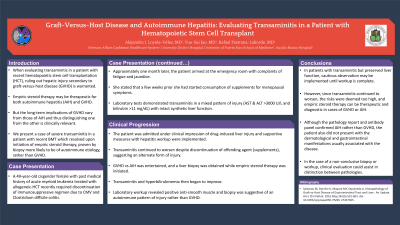Sunday Poster Session
Category: Liver
P1056 - Graft-Versus-Host Disease and Autoimmune Hepatitis: Evaluating Transaminitis in a Patient With Hematopoietic Stem Cell Transplant
Sunday, October 22, 2023
3:30 PM - 7:00 PM PT
Location: Exhibit Hall

Has Audio

Alejandro J. Loyola-Velez, MD
VA Caribbean Healthcare System
Isabela, PR
Presenting Author(s)
Alejandro J.. Loyola-Velez, MD1, Yue-Sai Jao-Ayala, MD2, Rafael Pastrana-Laborde, MD3
1VA Caribbean Healthcare System, Isabela, Puerto Rico; 2University of Puerto Rico Medical Sciences Campus, San Juan, Puerto Rico; 3Auxilio Mutuo Hospital, San Juan, Puerto Rico
Introduction: When evaluating transaminitis in a patient with recent hematopoietic stem cell transplantation (HCT), ruling out hepatic injury secondary to graft-versus-host disease (GVHD) is warranted. In certain cases, such as when suspicion for autoimmune hepatitis (AIH) or GVHD is high, empiric steroid therapy may be implemented, but the long-term implications of GVHD vary from those of AIH and thus distinguishing one from the other is clinically relevant. We present a case of severe transaminitis in a patient with recent BMT which resolved upon initiation of empiric steroid therapy, proven by biopsy more likely to be of autoimmune etiology, rather than GVHD.
Case Description/Methods: This is the case of a 49-year-old cisgender female with past medical history of acute myeloid leukemia treated with allogeneic-HCT complicated who recently required discontinuation of immunosuppressive regimen due to CMV and Clostridium difficile colitis. Approximately one month later, the patient arrived at the emergency room with complaints of fatigue and jaundice. She stated that a few weeks prior she had started consumption of supplements for menopausal symptoms. Laboratory tests demonstrated transaminitis in a mixed pattern of injury (AST & ALT >3000 U/L and bilirubin >11 mg/dL) with intact synthetic liver function. The patient was admitted under clinical impression of drug-induced liver injury and supportive measures with hepatitis workup were implemented. Transaminitis continued to worsen despite discontinuation of offending agent (supplements), suggesting an alternate form of injury. GVHD vs AIH was entertained, and a liver biopsy was obtained while empiric steroid therapy was initiated. Transaminitis and hyperbilirubinemia then began to improve. Laboratory workup revealed positive anti-smooth muscle and biopsy was suggestive of an autoimmune pattern of injury rather than GVHD.
Discussion: In patients with transaminitis but preserved liver function, cautious observation may be implemented until workup is complete. However, since transaminitis continued to worsen, the risks were deemed too high, and empiric steroid therapy can be therapeutic and diagnostic in cases of GVHD or AIH. Although the pathology report and antibody panel favored AIH rather than GVHD, the patient did not present with the dermatological and gastrointestinal manifestations usually associated with the disease. In the case of a non-conclusive biopsy or workup, clinical evaluation could assist in distinction between pathologies.
Disclosures:
Alejandro J.. Loyola-Velez, MD1, Yue-Sai Jao-Ayala, MD2, Rafael Pastrana-Laborde, MD3. P1056 - Graft-Versus-Host Disease and Autoimmune Hepatitis: Evaluating Transaminitis in a Patient With Hematopoietic Stem Cell Transplant, ACG 2023 Annual Scientific Meeting Abstracts. Vancouver, BC, Canada: American College of Gastroenterology.
1VA Caribbean Healthcare System, Isabela, Puerto Rico; 2University of Puerto Rico Medical Sciences Campus, San Juan, Puerto Rico; 3Auxilio Mutuo Hospital, San Juan, Puerto Rico
Introduction: When evaluating transaminitis in a patient with recent hematopoietic stem cell transplantation (HCT), ruling out hepatic injury secondary to graft-versus-host disease (GVHD) is warranted. In certain cases, such as when suspicion for autoimmune hepatitis (AIH) or GVHD is high, empiric steroid therapy may be implemented, but the long-term implications of GVHD vary from those of AIH and thus distinguishing one from the other is clinically relevant. We present a case of severe transaminitis in a patient with recent BMT which resolved upon initiation of empiric steroid therapy, proven by biopsy more likely to be of autoimmune etiology, rather than GVHD.
Case Description/Methods: This is the case of a 49-year-old cisgender female with past medical history of acute myeloid leukemia treated with allogeneic-HCT complicated who recently required discontinuation of immunosuppressive regimen due to CMV and Clostridium difficile colitis. Approximately one month later, the patient arrived at the emergency room with complaints of fatigue and jaundice. She stated that a few weeks prior she had started consumption of supplements for menopausal symptoms. Laboratory tests demonstrated transaminitis in a mixed pattern of injury (AST & ALT >3000 U/L and bilirubin >11 mg/dL) with intact synthetic liver function. The patient was admitted under clinical impression of drug-induced liver injury and supportive measures with hepatitis workup were implemented. Transaminitis continued to worsen despite discontinuation of offending agent (supplements), suggesting an alternate form of injury. GVHD vs AIH was entertained, and a liver biopsy was obtained while empiric steroid therapy was initiated. Transaminitis and hyperbilirubinemia then began to improve. Laboratory workup revealed positive anti-smooth muscle and biopsy was suggestive of an autoimmune pattern of injury rather than GVHD.
Discussion: In patients with transaminitis but preserved liver function, cautious observation may be implemented until workup is complete. However, since transaminitis continued to worsen, the risks were deemed too high, and empiric steroid therapy can be therapeutic and diagnostic in cases of GVHD or AIH. Although the pathology report and antibody panel favored AIH rather than GVHD, the patient did not present with the dermatological and gastrointestinal manifestations usually associated with the disease. In the case of a non-conclusive biopsy or workup, clinical evaluation could assist in distinction between pathologies.
Disclosures:
Alejandro Loyola-Velez indicated no relevant financial relationships.
Yue-Sai Jao-Ayala indicated no relevant financial relationships.
Rafael Pastrana-Laborde: Abbvie – Speaker for Mavyret.
Alejandro J.. Loyola-Velez, MD1, Yue-Sai Jao-Ayala, MD2, Rafael Pastrana-Laborde, MD3. P1056 - Graft-Versus-Host Disease and Autoimmune Hepatitis: Evaluating Transaminitis in a Patient With Hematopoietic Stem Cell Transplant, ACG 2023 Annual Scientific Meeting Abstracts. Vancouver, BC, Canada: American College of Gastroenterology.
